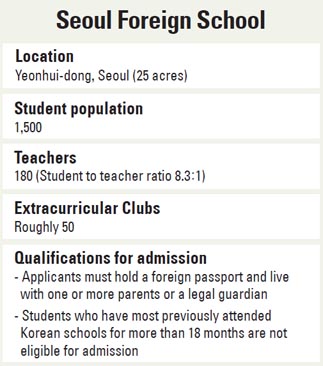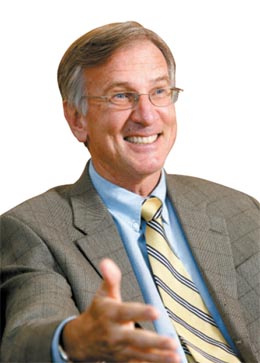A foreign school with a family feel

Founded in 1912 by seven Christian missionaries with a class of just 18 students and one full-time teacher, Seoul Foreign School prides itself on being the oldest international school in Korea and one of the oldest in the world.
Having laid down the foundation for many other international schools today, the quiet, 25-acre campus in Yeonhui-dong, Seoul, has uniformed children walking in rows - in contrast to the neighborhood outside, which bustles with people and traffic throughout the week.
The school has a student body of 1,500 - which includes students of more than 30 nationalities from preschool to 12th grade - and a staff consisting of 180 teachers and 150 other faculty members. It offers advanced placement classes and an international baccalaureate program that enables students to go to the university of their choice after high school. The school has a university entrance rate of 100 percent.

Students participate in a class at Seoul Foreign School. By Oh Sang-min
One of the noticeable traits about SFS is that it has a British school division that students can choose to attend until high school, when all students follow a largely American curriculum. According to the admissions staff, many of the students who hail from European countries tend to gravitate towards the British division.
John Engstrom, 64, became head of the school in July 2009. He is leading the school at a crucial point in its long history - it is celebrating its centennial next year. Engstrom received his masters in chemistry at the State University of New York at Stony Brook and his doctorate in science education at Columbia University.
He and his wife, Alice, a school nurse, are veterans of international schools. Engstrom worked in Germany in 1973 as a physical education and science teacher, in India in 1984 and was head of a school in Switzerland from 1990 to 1994. Then they headed back home to the states and settled in Minnesota, where Engstrom was a principal at a private school for 15 years from 1994 to 2009.
“Toward the end of that time, we decided we wanted to do something different and we were looking for a new challenge,” he said. “Then we heard about the position in Seoul. We loved the school, liked the people right away.”

To him, they are like family.
The majority of faculty members live on campus, which helps support the family-oriented atmosphere.
“We have a real community feel here,” said Nicole Oakes, one of the two admissions directors at the school.
Two of Oakes’ own children attend SFS. Because the teachers are so close by, faculty members’ children have access to their parents all the time, which she says is advantageous for both parents and children alike.
Another point that sets the school apart is that it has more students from foreign families than other international schools in Korea, because SFS only accepts students with foreign passports.
“We make it our priority to serve the children of foreign families first,” Oakes said.

John Engstrom, head of SFS
It is possible for Korean children who have lived abroad for a number of years to apply for admission to the school, said Rose Robinson, another of the school’s admissions directors, but they are placed at the bottom of the acceptance list.
To gain admission to the school, students must submit their academic records, examples of their work, teacher references and health records. They must also take a mathematics and English assessment test.
Applications for admission and tuition payments can be made online and the entire process can take from a few days to a whole month, depending on how quickly the families produce the necessary papers, Oakes said.
Tuition fees are around $20,000 on average, excluding special after-school classes.
Before an application is submitted, parents are welcome to meet with faculty to discuss questions they have about the school.
After the admissions process is complete, students are put through a rigorous and appropriate curriculum, Engstrom said.
Timothy Cho, 17, the head of the SFS student council, agrees.
“It’s definitely harder and we’re challenged to study,” said Cho, who attended a public school in California before coming to SFS. “All the teachers [at SFS] are actually good at teaching. And we’re not Korean like the other international schools.”
Cho said that the school provides an eye-opening experience for students, as well as a gateway to different opportunities.
Because the school’s education system is known for being especially challenging, and because of its long history here, other international schools have long looked to SFS for advice.
Engstrom says he is very much in favor of this kind of cooperation between international schools in Korea.
The former head at SFS offered extensive advice to other international schools, such as the Korea International School, when they were first being built, he said.
“It’s a really personal relationship and it’s about supporting each other,” Engstrom said. “It’s not about competition. It is a real supportive environment.”
Engstrom is also looking forward to improving SFS. In particular he said he hopes to make it a top-notch school for science.
Considering its age, one might be tempted think that the school is not as modern and high-tech as some of the newer, flashier international schools popping up in Korea left and right, but the headmaster says that the opposite is true.
“I think we’ve invested $5 million in technology over the last three years,” Engstrom said.
An introductory pamphlet said the school has also invested $30 million into its facilities over the past five years.
Apart from this, what is most important for the school at the end of the day is the students and encouraging their interest in learning.
“I would like the students to jump in with both feet,” Engstrom said. “Get into different activities and embrace the entire experience.”
By Christine Kim [christine.kim@joongang.co.kr]










with the Korea JoongAng Daily
To write comments, please log in to one of the accounts.
Standards Board Policy (0/250자)